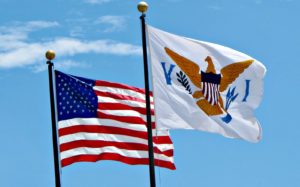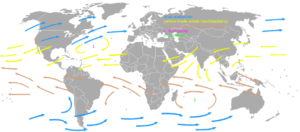 As if our island’s natural beauty isn’t enough, Mother Nature is kind to St. Croix with our trade winds. Much of the time, trade winds hold temperatures between 75 and 85 degrees Fahrenheit, seldom going above 90 and never below 60. But how does she do it?
As if our island’s natural beauty isn’t enough, Mother Nature is kind to St. Croix with our trade winds. Much of the time, trade winds hold temperatures between 75 and 85 degrees Fahrenheit, seldom going above 90 and never below 60. But how does she do it?
Within a 10-degree band at the equator, intense solar heat warms and moistens the air, which rises and moves toward the poles. As the air cools, it settles and moves to the band at the equator, triggering the calm trade winds. The trade winds move within a 60-degree band at the equator (30 degrees north and 30 degrees south).

A diagram of trade winds from Wikipedia
Winds are blown to the west in both hemispheres due to the Coriolis Effect, named for the Frenchman who discovered the phenomenon in the 1800’s. The winds are named for the direction from which they are blown, thus northeasterly trade winds in the Northern Hemisphere and the southeasterly trade winds are in the Southern Hemisphere.
These prevailing trade winds reliably track through the U.S. Virgin Islands, providing a nice, cooling breeze.
History of Trade Winds
The prevailing trade winds and related ocean currents made early sailing ship travel possible, from Europe and Africa to the Americas, and from the Americas to Asia. As early as the 14th century, the word “trade” meant “path” or “track”. In the early 15th century, the Portuguese became aware of the importance of the trade winds, translated in Portuguese to mean “turn of the sea” or “return from the sea” in navigation. By the 18th century, the term “trade winds” literally meant winds that facilitated trade, or foreign commerce for the English merchant fleet.
Christopher Columbus used these clockwise circular, northeasterly trade winds to make his historic voyages possible. Otherwise, the journey time required too much food and water. His ships were propelled westward for five weeks from the Canary Islands off northwestern Africa. Then returning to Spain, he navigated the prevailing winds northwestward to the middle latitudes of the North Atlantic. The prevailing winds here are eastward to Europe then southward. On his 2nd voyage in 1493, he stopped on St. Croix at the North Shore, now within the Salt River Bay Historical and Ecological Preserve.
Much like our predecessors, Virgin Islanders rely on the trade winds to make sailing voyages faster, as well as a little natural air conditioning.
Source: Wikipedia


Recent Comments